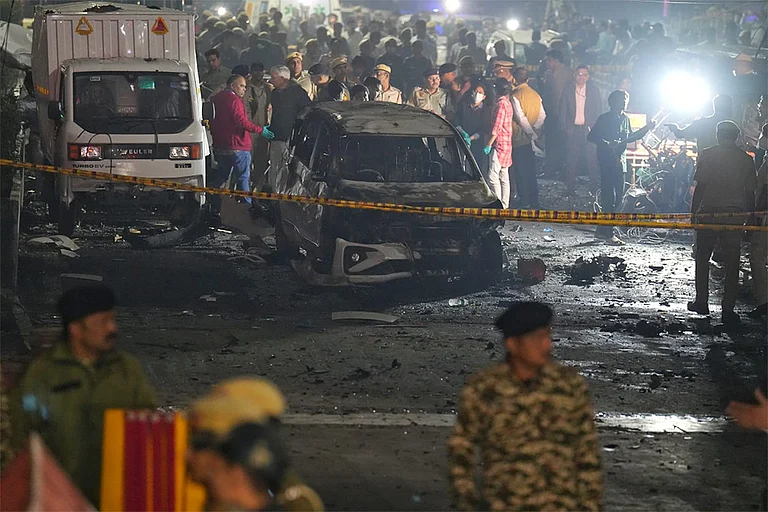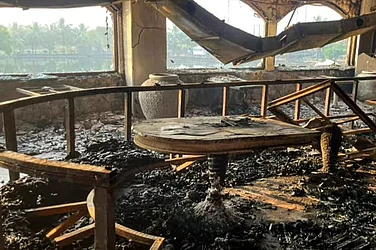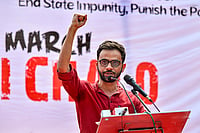
Families of victims spent the night searching LNJP Hospital for missing loved ones after the Red Fort blast, with confirmations of death coming only after hours of anguish.
Survivors and relatives faced chaotic scenes at the hospital as officials visited the injured and families awaited news, with many victims being cab and auto-rickshaw drivers.
Two e-rickshaw drivers, Jumman and Mohsin, were among those killed, leaving behind young families who depended on them.
Kashmiri and Muslim residents in Delhi reported rising suspicion and prejudice in the aftermath, describing renewed fear as advisories, verification demands and social scrutiny intensified.
It was a night weighed down by grief. Voices cracked in the chaos around Delhi’s Red Fort in the national capital while families moved through the dark with nothing but hope to guide them.
The blast on November 10 was not only measured in blaring ambulances and frantic police calls. Its onerous weight was felt in the silence between those waiting for news and in the unease that settled over communities now shadowed by suspicion. In the centre of the capital, the violence left marks that do not appear on any casualty list.
As the news travelled through the city, Mohammad Jumman’s wife, Tanuja, reached Lok Nayak Jaya Prakash (LNJP) Hospital, near Delhi Gate, in panic with their 10-year-old son. His brother Chand moved between the gates in disbelief. Jumman, 35, from Shastri Nagar in Northeast Delhi, had last been traced near Lal Qila (Red Fort), where he was stuck in traffic at the time of the blast. Then his phone went silent. He had told his wife he would be home for dinner. Now his son held up photographs of him to anyone willing to pause. Jumman leaves behind three children and a household forced into sudden and brutal loss.
Across the hospital, Mohammad Mohsin’s family faced the same anguish. Mohsin, 35, from Meerut, had moved to Delhi two years ago with his wife and two children. His phone was found at the blast site. His sister-in-law hounded the media crews as she showed his photograph on her phone while sobbing. The hospital staff had first told the family he was not on the list of the injured. Through the night both families moved between LNJP hospital’s emergency ward and the mortuary as they searched for confirmation and held on to hope.
“All night we kept looking,” Tanuja said, her voice breaking, as she tried to shield her son from TV cameras. “We checked everywhere and every stretcher. We thought maybe he was unconscious somewhere. Maybe someone admitted him without telling us.”
Nearly 12 hours after the explosion, Jumman and Mohsin were eventually confirmed dead. Identification was slow and Jumman was recognised only through his clothes. The names of the two e-rickshaw drivers in Old Delhi were added to the official list by the next afternoon. Jumman supported his physically challenged wife and three children and Mohsin supported his wife and two children after his father fell ill. Outside the hospital, chaos continued as ambulances arrived and police held back anxious crowds. Officials visited the injured while relatives searched for their dead. Thirteen people were killed and over 20 were injured in the blast.
Outside Gate No. 4, the hospital had become a space of half-finished prayers and trembling hands. Families did not know if the next name called would bring relief or devastation. The blast had scattered bodies and shattered glass and left unanswered calls ringing through the by-lanes of Old Delhi. At the hospital, relatives pleaded at the gates. Among them were the relatives of Mohammad Shahnawaz, a 35-year-old cab driver. They had rushed to LNJP hospital after a brief call and waited for hours clutching plastic water bottles and scraps of information.
“We did not know much, just that he’s alive,” Aarafin said, his eyes fixed on the gate. Only Shahnawaz’s wife, Bushra, was allowed inside. When she returned, she said he had injuries on his face and across his body, but he was conscious. Outside, his relatives whispered their relief. The cab he had been driving and was parked near the site was completely destroyed. Many of the injured were cab and auto-rickshaw drivers who usually await passengers near the metro station.
Not far away another group of anxious relatives waited in silence. Shailendra Jaiswal kept refreshing his phone and scanning the news as he tried not to imagine the worst. His 27-year-old nephew, Shiva, a garment trader from Uttar Pradesh, had been expected at his Kalkaji home that afternoon. Shiva travelled to Chandni Chowk for work and when he did not arrive, Shailendra called him repeatedly before starting his own search. “When the news alerts about the explosion started flashing, I watched TV footage of (Union) Home Minister Amit Shah visiting the injured at LNJP,” he said. The familiar face in the background on-screen caught his attention. Shiva was on a hospital bed, eyes half-open. “My hands went cold,” he said. “I knew it was him.” The hospital soon followed with official confirmation. “At least we found him,” he said.
In the days that followed, Kashmiris in Delhi said an invisible wave of suspicion had spread through the city.
In another corner of the hospital grounds, the family of Mohammad Farooq waited on a low parapet. Farooq, a 55-year-old refrigerator mechanic from Kucha Challan, had been caught in the blast while heading to Lal Qila for a repair job. “We don’t know how serious it is,” said his wife, clutching her phone as if waiting for certainty. After a night of fear, she said they were at least grateful he was alive, although injured.
Inside the hospital the injured lay in rows. Some were bandaged, others were groggy with medication and several were still in shock. Outside, the names of the dead filtered through slowly, carried by police confirmations and relatives returning from the mortuary. Some arrived holding Aadhaar cards or photographs. Others relied on memory. A scar, a shirt colour, a phone wallpaper. Small details that might help them recognise someone changed by violence. Doctors said most patients had suffered shrapnel burns, deep cuts and fractures. People waited and told each other where their loved ones had been that day. A mechanic heading to a job. A cab driver waiting for a fare. A trader returning from Chandni Chowk. Nothing in their day had pointed to a catastrophe.
As the city grappled with the rising death toll, the focus shifted to Al Falah University in Dhauj, Faridabad, on the outskirts of Delhi. The university became the centre of national scrutiny after the blast. Media vans lined its sealed gates as police and forensic teams moved in and out. A campus once described as quiet was now marked by interrogations and suspicion.
Investigators concentrated on three doctors linked to the university. Umar Un Nabi, a doctor, is alleged to have driven the Hyundai i20 that exploded near the Red Fort. Nabi and Muzammil Ahmad Ganaie, another doctor, are from Kashmir. Police alleged that a campus lab had links to the terror module and pointed to the recovery of nearly 2,900 kg of explosives from two rented premises near the university.
The administration denied any wrongdoing and said no prohibited materials were stored on the campus and that the accused were carrying out regular duties. Vice Chancellor Bhupinder Kaur Anand said, “No prohibited or explosive materials were used or stored on campus. The accused were employees fulfilling their duties.”
The university now sits at the intersection of academic routine, national security investigations, media attention and community anxiety. Guards held a strict line at the entrance and repeated that only patients and students were allowed inside. Students moved cautiously, avoiding the areas where cameras gathered. The campus has a significant population of Kashmiri and Muslim students and tension remained high. Many avoided the main gate. One student said, “We are scared of being visible. The moment someone hears where we are from or which university we study at, we don’t know what they will assume.” Another said, “Hum class ke liye bhi nikalne se darr rahe hain. Ek galat clip, ek galat headline (We are afraid to even step out of class. One misinterpreted video clip, one erroneous headline)… and our whole life can change.” A third added, “Even walking to class feels like stepping into a narrative we didn’t choose.”
Scrutiny soon widened. The Association of Indian Universities suspended the varsity’s membership and the National Assessment and Accreditation Council issued a show cause notice over alleged misrepresentation of accreditation. “Hamari zimmedari nahi thi yeh. Lekin nishaan hum pe aa gaya (This was not our responsibility. There is stigma linked to us now),” a student said. Another added, “We came here to study. We have nothing to do with any of this. But suddenly our university is mentioned everywhere. We don’t know how to deal with it.” A student from Budgam said, “If they are saying that the accreditation of the university expired five years back, why wasn’t any action taken since.”
Meanwhile, the authorities described the operation as an “interstate white-collar terror network” with the investigation stretching to Pulwama in Kashmir. In Koil village, the home where the accused Umar Nabi grew up was razed in what officials called a “controlled demolition”. It was presented as part of dismantling the alleged module’s support structures. For some the demolition was also a spectacle of loss.
Jammu and Kashmir Chief Minister Omar Abdullah said such actions risk alienating entire communities even as he condemned the Red Fort blast. “If these things had stopped terrorism, it would have ended by now… I fear such things would only increase anger.” Srinagar MP Aga Ruhullah Mehdi called the demolition “collective suffering” and pointed to the cruelty of making a family homeless without a clear court order in harsh winter conditions. For many Kashmiris the sight of the home being razed revived old anxieties even as officials said the act was procedural and part of a wider security operation.
In the days that followed, Kashmiris in Delhi said an invisible wave of suspicion had spread through the city. Residents’ groups in Gurugram received advisories to submit lists of Kashmiri and foreign residents. Some landlords and employers began asking for “verification”. For many this brought back memories of earlier crackdowns after the Pulwama attack and Operation Sindoor. A Kashmiri student in North Delhi said, “It’s like a cycle of fear, silence, and waiting. You try to go about your life, but someone is always watching. Sometimes, I feel guilty for being born in that place.”
Kashmiri and Muslim residents described the atmosphere as old anxieties in new forms. “Even if the accused turn out to be someone else, the damage is already done. People look at us differently. In the way they hold their gaze, how they ask questions,” said a student. “We are neither terrorists nor conspirators, yet every time we step out, all eyes are on us. That’s the real aftershock. The one that lasts much longer than the blast itself,” said a businessman. Another student said, “Violence has an epicentre. But prejudice spreads differently. It settles on people who had no part in the tragedy, shaping daily life in ways you can’t control.”
Social media, too, amplified unease with hashtags like white-collar modules, fuelling mistrust before any official conclusion, but political leaders called for restraint. CM Abdullah, condemning the blast, emphasised, “Not every person in Jammu and Kashmir is a terrorist, nor does every Kashmiri support militants. Only a small minority has consistently sought to disrupt peace and communal harmony.”
Fozia Yasin is a journalist and researcher exploring the stories and lives at the margins
MORE FROM THIS ISSUE
This article appeared as 'Night in Grief' in Outlook’s December 1, 2025 issue as 'The Burden of Bihar' which explores how the latest election results tell their own story of continuity and aspiration, and the new government inherits a mandate weighted with expectations. The issue reveals how politics, people, and power intersect in ways that shape who we are—and where we go next.



































